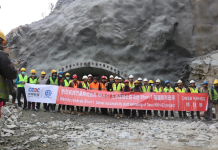BEIJING: Last year, the National Cultural Heritage Administration announced that the Jiangcun Grand Tomb in Xi’an, Shaanxi province, is the resting place of Emperor Wen, who reigned during the Han Dynasty (206 BC-AD 220).
It came as a surprise because for centuries, ancient literature had led scholars to believe the tomb was in another location about 2 kilometers away. m
The finding was the result of an archaeological excavation that started in 2017, a protective measure of last resort that was prompted by frequent tomb raids at the site.
All of those who participated in the raids have been caught and prosecuted.
In recent years, tomb raiders have become more sophisticated.
They are equipped with better tools and a better understanding of cultural relics.
They also have established clear divisions of labor and have made use of the internet to assist them in their crimes, according to Wang Yunxia, director of the Institute of Cultural Heritage Law affiliated to the Law School of the Renmin University of China.
“To a large extent, it has become more difficult to crack down on these types of crimes,” she said.
–The Daily Mail-China Daily news exchange item






